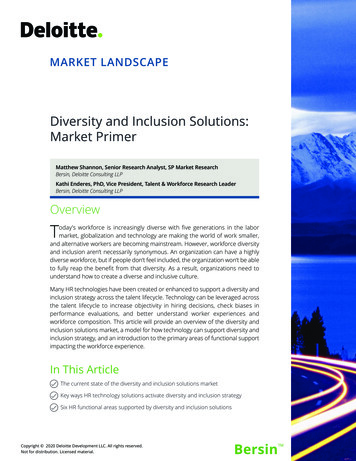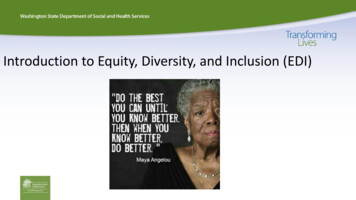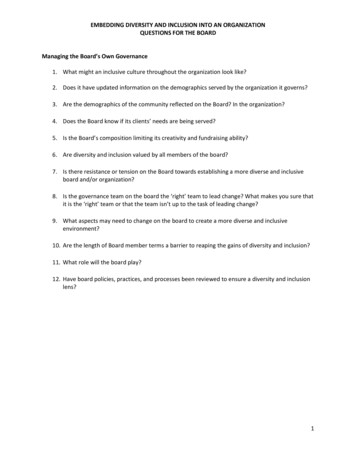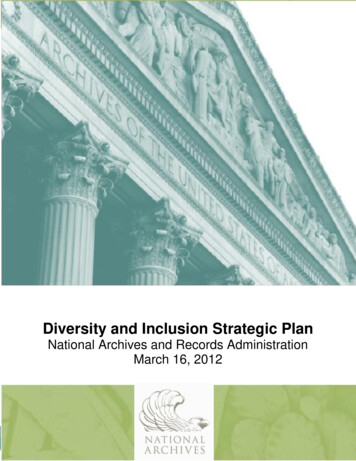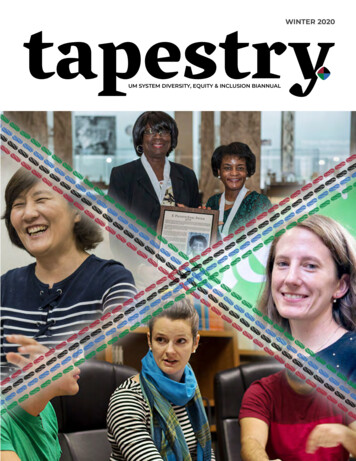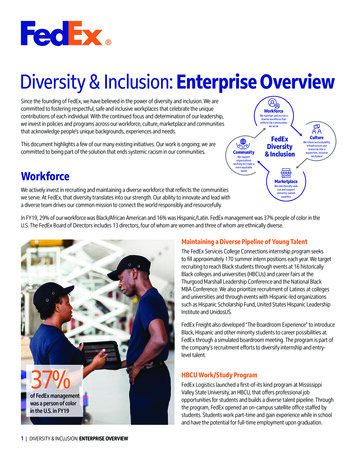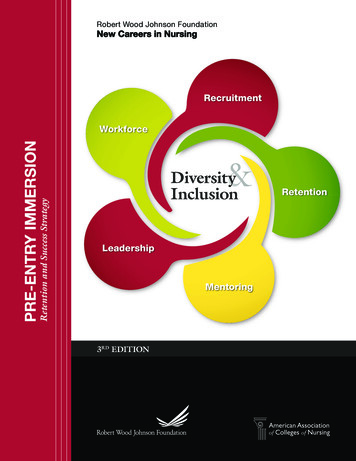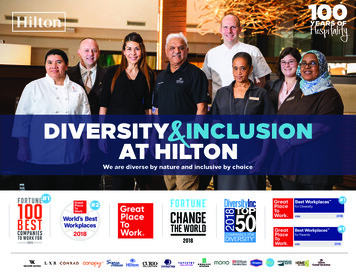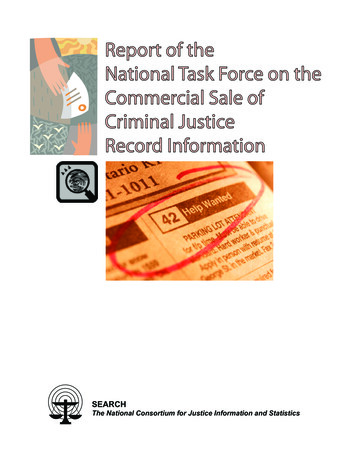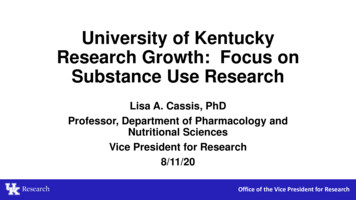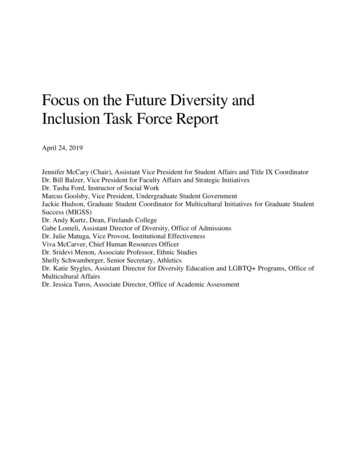
Transcription
Focus on the Future Diversity andInclusion Task Force ReportApril 24, 2019Jennifer McCary (Chair), Assistant Vice President for Student Affairs and Title IX CoordinatorDr. Bill Balzer, Vice President for Faculty Affairs and Strategic InitiativesDr. Tasha Ford, Instructor of Social WorkMarcus Goolsby, Vice President, Undergraduate Student GovernmentJackie Hudson, Graduate Student Coordinator for Multicultural Initiatives for Graduate StudentSuccess (MIGSS)Dr. Andy Kurtz, Dean, Firelands CollegeGabe Lomeli, Assistant Director of Diversity, Office of AdmissionsDr. Julie Matuga, Vice Provost, Institutional EffectivenessViva McCarver, Chief Human Resources OfficerDr. Sridevi Menon, Associate Professor, Ethnic StudiesShelly Schwamberger, Senior Secretary, AthleticsDr. Katie Stygles, Assistant Director for Diversity Education and LGBTQ Programs, Office ofMulticultural AffairsDr. Jessica Turos, Associate Director, Office of Academic Assessment
2AcknowledgmentsThe authors express their gratitude to President Rodney K. Rogers, his commitment to diversityand inclusion and for the opportunity to participate in meaningful discussion about this criticaltopic. The perspectives, values, and feedback shared throughout this semester were inspiring andleft us hopeful that genuine, tangible, and meaningful change will continue to happen. Theauthors also wish to thank the past and present members of the President’s Advisory Council onDiversity and Inclusion (PACODI) for many years of service to the campus community and forguiding the work of this Task Force.
3Executive SummaryFollowing President Rogers’ charge to the Focus on the Future Task Force on Diversity andInclusion, the Task Force reviewed the current state of BGSU’s diversity and inclusion effortsand assessed evidence on the effectiveness of those diversity and inclusion efforts implemented.Based on our work, the Task Force makes the following recommendations:1. Recommended for Organizational Structure1.1. Either a separate division led by a new Vice President with co-authority over diversityand inclusion efforts in other divisions or a unit led by a Chief Diversity Officer whoreports to the President1.2. The preferred title for the division or unit is Equity, Diversity, and Inclusion orDiversity, Inclusion, and Belonging1.3. LGBTQ Programs should become an office separate from the Office of MulticulturalAffairs2. Recommended Areas of Responsibility/Collaboration Related to Diversity and Inclusion2.1. Inclusive pedagogy professional development for instructors2.2. Faculty and staff training (e.g., implicit bias, prejudice, racism, and harassment)2.3. Curricular, co-curricular and extra-curricular programming2.4. Recruitment and retention of students, faculty, staff, and administrators frommarginalized groups2.5. Implementation and evaluation of strategic goals2.6. Monitoring and accountability2.7. Accessibility3. Recommended Adoption of Standard Definitions of Diversity, Equity, and InclusionProposed by Task Force4. Recommended Increases in Support and Accountability4.1. Required inclusive pedagogy professional development for all faculty4.2. Utilization of diversity and inclusion data and metrics for accountability (e.g., an“Inclusive Excellence Scorecard” developed with input from relevant constituents)4.3. Diverse representation (e.g., race, ethnicity, gender) on all hiring committees andcommittees granting funding from any source (e.g., scholarship committees)4.4. Mandatory diversity and inclusion training for all students, faculty, staff, andadministrators to increase multicultural competence (i.e., awareness, knowledge, andskills) and the addition of cultural competence and commitment to diversity in employeeperformance evaluations5. Recommended Resource (Re)Allocation to Support Task Force Recommendations5.1. Intentional reallocation of existing faculty, staff, and administrators5.2. Earmarked investments of new resources and resource savings from improvements inefficiency
46. Recommended Changes to Current Diversity and Inclusion Committees6.1. President’s Advisory Council on Diversity and Inclusion (PACODI): Implementimprovements based on review/assessment of current structure and charge6.2. Students’ Advisory Council on Diversity and Inclusion (SACODI): Continue currentcharge and structure6.3. Dean’s Advisory Council on Diversity and Inclusion (DACODI): Each college shouldimplement DACODI or a similar committee6.4. Not In Our Town (NIOT): Single committee chair from the Bowling Green communitywith continued formal involvement by the university
5IntroductionOn December 5, 2018, President Rogers charged the Focus on the Future Diversity and InclusionTask Force (“Task Force”) to: Review the current state of BGSUs diversity and inclusion efforts through a review ofsurveys, reports, and plans;Determine what has worked and what has not worked;Recommend an organizational structure for diversity and inclusion moving forward;Review and recommend additional areas for BGSU to provide increased support,research, and measures of effectiveness for a more robust BGSU diversity and inclusionprogram; andRecommend whether any longer-term adjustments to current diversity committees suchas PACODI, SACODI, DACODI, and Not in Our Town are needed.The Task Force included university faculty, student, administrator, and classified staffrepresentatives from across different areas and campuses. The charge to the Task Force followedObjective 3, Initiative 1 of the Focus on the Future strategic plan:Empowering and supporting people to achieve excellence.Objective 3: Support all individuals to build a quality learningcommunity that fosters diversity and inclusion, collaboration, creativity,and excellence. Initiative 1: We will enhance and support a culture thatvalues diversity and inclusion by developing and implementing acomprehensive (detailed and outcomes-oriented), strategic diversity planthat increases the recruitment, retention, and success of a diverse studentbody, faculty, staff, and administration.(Focus on the future advancing BGSU’s strategic plan 2018-2023, pg. 4)
6Definition of Diversity, Equity, and InclusionThe Task Force on Diversity and Inclusion began with discovery work to determine how BGSUhas expressed a commitment to diversity and inclusion, including how the university historicallyhas chosen to define the parameters around which discussions of diversity and inclusion takeplace. While the Task Force was unable to identify a university standard definition of diversity,the Task Force found a statement on diversity in a 1999 resolution passed by the Board ofTrustees (see Appendix A):Bowling Green State University embraces, as an important educational value, the idealof a diverse institution. The University fosters an environment, which reflects andcelebrates diversity, promotes tolerance and civility, encourages inclusion, embraceshealthy interdependence, and promises to all members a learning community free ofdiscrimination and harassment.Bowling Green State University Board of Trustees, 1999-2000While the values expressed in this statement are laudable, this Task Force could find no evidenceof the university periodically exploring its relevance, even in the face of a rapidly evolvingpolitical, social, and cultural landscape. Indeed, that BGSU continues to express its commitmentto diversity and inclusion in such aspirational terms would seem to suggest that BGSU, likemany universities, struggles to achieve these goals. At the same time, we must be certain thatterminology reflects our institutional values in the moment, moving beyond an emphasis ontolerance to a definition that acknowledges the need for a more proactive agenda. Thus, for thepurpose of this white paper, our working definitions are as follows:Diversity is the recognition of intersecting identities and social hierarchies, particularly relatedto race, ethnicity, gender, sexual orientation, age, ability, religion, and socio-economic status.The historical unequal distribution of power, privilege and resources, itself a mark of diversity,simultaneously impacts current experiences and future possibilities of individuals engaged inhigher education in the United States (modified from BGSU Inclusion Network, 2012, as cited inStudent Affairs Diversity Committee, 2014).Equity is the practice of ensuring that personal or social circumstances, such as protected classor intersecting identities, are not obstacles to achieving one’s potential. Equity is reflected inpolicies and processes which acknowledge that we live in a world where not all members areafforded the same resources, treatment, and opportunity, and works to remedy this fact (modifiedfrom Equity and Quality in Education, 2012).Inclusion is the result of a successful alignment of diversity and equity. As Williams writes,“Inclusion exists when traditionally marginalized individuals and groups feel a sense ofbelonging and are empowered to participate in majority culture as full and valued members ofthe community, shaping and redefining that culture in different ways” (Williams, 2013, p. 90).
7Task Force Charge 1. Review the current state of BGSU’s diversity andinclusion efforts through a review of surveys, reports, and plansIn an effort to assess the current state of BGSU’s diversity and inclusion efforts, the Task Forcereviewed several documents: 2018 PACODI Recommendations on Strategies for the Recruitment and Retention ofFaculty of Color at BGSU;2016 PACODI Faculty and Staff Climate Survey Report;2016 report of priorities identified at a PACODI faculty and staff of color event;2005 Diversity Leadership Team Ad Hoc Report; and2002 Report of the University Task Force on Diversity.A summary of the findings and recommendations of these reports is included in Appendix B.As an organizing framework, the Task Force sorted the comprehensive list of major findings andrecommendations from these reports into an overarching set of institutional practices thatinfluence the perceptions, attitudes, and behaviors of individuals in the institution (adapted fromD. Katz and R. Kahn, 1978). The findings aligned with the following practices: Leadership Practices: The words and actions of leaders to direct behaviors of othersStrategic Plans: Direct the commitment of university resources toward establishedpriorities identified as critical to institutional successJob Design & Roles: The assignment of standard tasks and formalized behaviors andresponsibilities across jobs that are required for the institution to deliver a service orproductOrganizational Design & Structure: the vertical and horizontal division andcoordination of jobs and roles to maximize efficiency and effectivenessMotivation & Reward Practices: Intrinsic (e.g., enriched work) and extrinsic (e.g.,recognition) efforts to ensure the timeliness, quantity, and quality of performanceCommunication Practices: The exchange of information among individuals andsystems to meet work-related and social needsPersonnel Practices: Employment-related activities (e.g., recruitment, hiring,onboarding, training, evaluation, etc.) to provide the workforce needed for institutionalsuccessPower & Influence: Institutional or personal authority to help assure the consistency andappropriateness of behaviorsDecision Making Practices: The use of information and involvement of all stakeholdersin making organizational decisionsAppendix C shows the distribution of the major findings and recommendations from earlierreports across the institutional practices listed above. A summary listing of pastrecommendations aligned with the institutional practices rubric is below:
8 Leadership: enact inclusive leadership training, required diversity strategic plans foreach VP area, and annual reviews regarding equity, diversity, and inclusion-relatedprogress.Job Design and Roles: integrate multicultural competence within all positions at theuniversity. Reduce “service tax” on underrepresented faculty and staff, and mentorunderrepresented faculty, staff, and students. Adapted from Padilla (1994), “service tax”is a term used to describe the unequal burden placed on underrepresented faculty andstaff in the fulfillment of their service obligations to the university.Organizational Design and Structure: continue to formally assess the climate andaddress the lack of diversity. Establish a central office for diversity initiatives with apermanent operating budget and establish formal diversity networks and communities.Motivation and Reward Practices: officially recognize diversity leaders. Holdadministrators accountable for and incentivize the recruitment and retention ofunderrepresented faculty and staff.Communication Practices: define diversity and develop an ongoing diversity andinclusion communication plan. Institute an Equity Diversity and Inclusion (EDI) annualreport to the President and Board of Trustees. Increase advertising for EDI programs andservices.Personnel Practices: promote and foster EDI in the recruitment and retention of facultyand staff. Streamline and expedite the recruitment/hiring processes and offer mandatorytrainings and workshops to increase cultural competence for faculty and staff. IncorporateEDI initiatives into faculty and staff evaluations. Create a hiring manual includingstrengthened job recruitment material for underrepresented faculty and staff. Implementtraining on implicit bias and discriminatory practices for search committees.Decision Making Practices: expand the discussion of institutional diversity andinclusion issues from one emphasizing compliance to one that includes university-widestrong knowledge base and implementation. Establish a fund (similar to Ethnic CulturalArts Program - ECAP) to sponsor multicultural programs and activities for studentorganizations.
9Task Force Charge 2. Determine what has worked and what has notworkedAppendix B includes the Task Force’s summary of (a) whether the major findings andrecommendations from earlier reports have been implemented by the University and, whereimplemented, (b) whether the major findings and recommendations from earlier reports havebeen assessed to determine their impact or effectiveness. As shown in Appendix C, very few ofthe findings from the five reports have been implemented by BGSU. In addition, for the fewfindings and recommendations implemented, formal assessment was not conducted.What has workedAcknowledging diversity and advocating for inclusion is imperative for all institutions. As aninstitution of higher education, which espouses the importance of personal growth throughliberal education, BGSU’s investment in a culture of diversity and inclusion is especiallysignificant. Historical statements on the importance of diversity and inclusion, as well as theirappearance in strategic planning documents and in charges related to special initiatives such asthe PACODI, suggest that BGSU understands the value of institutional change.Hiring practices are inextricably linked to an institution’s investment in growing a culture ofinclusion. At BGSU, the Office of Human Resources currently conducts regular meetings withcontracting officers to ensure equal access to open positions at BGSU continues, as they areinstrumental in educating and sharing data pertinent to achieving BGSU strategic goals.Moreover, the Affirmative Action Plan and the related Affirmative Action Walk-Aroundmeetings combine to create a management tool that ensures equal opportunity and providesdeans and division leaders with a platform to share best practices.Equally important is BGSU’s commitment to a learning environment designed to reach studentsof all abilities. Inclusive pedagogy is one of the main areas of focus of the Center for FacultyExcellence (CFE), and the CFE supports several initiatives that promote inclusive pedagogy atBGSU. These initiatives are ongoing, intentional, and integrated in the approach to supportingfaculty and students within BGSU learning environments. The CFE has a dedicated FacultyAssociate who focuses on diversity and inclusion initiatives and serves as a resource and anactive participant with other faculty, staff, administrators, and graduate students. BGSU becamean institutional member of the National Center for Faculty Development and Diversity (NCFDD)in spring 2016. As a member of NCFDD, BGSU faculty and students have access to professionaldevelopment materials and resources to support faculty success. In addition, the CFE hosts bookclub discussions on inclusive pedagogical practices, facilitates inclusive pedagogy professionaldevelopment sessions, and provides inclusive pedagogy strategies and resources.Finally, in 2013, each College was asked to submit a diversity plan. These plans vary in formatand complexity. Although they never reached their full potential, these plans could provide astarting point for renewed efforts at the college level. Below are a few highlights of successesfrom the colleges’ diversity plans:
10 The College of Arts and Sciences Diversity Committee recently hired their first Diversityand Inclusion Faculty Fellow, who is tasked with leading the A&S Diversity Committee;advancing best practices around recruitment, screening, and selection of candidates;exploring the mentoring needs of individuals and groups of faculty; and establishingsupportive professional development practices.The College of Business Dean’s Advisory Council on Diversity and Inclusion is currentlya model for other colleges to consider following as they submit a plan with metrics andhost programs to help infuse diversity and inclusion into their work.BGSU Firelands recently hired a Coordinator for Student Engagement, Diversity andInclusion, who has already been instrumental in centering the experiences of diversestudents, faculty, and staff and promoting increased inclusion of a number ofmarginalized identity groups.The University Libraries also has a Dean’s Advisory Council on Diversity and Inclusion.What has not workedInternal surveys and studies conducted over the last decade have identified, repeatedly, importantgaps and issues undermining BGSU’s efforts to build a strong and diverse community. Thisdisconnect, between the aspirational statements found in documents like the BGSU StrategicPlan 2011-2017 and the actual “lived” conditions of faculty, staff, and students, is symptomaticof our failure to fully create an ecosystem supporting BGSU’s strategic objectives. Thus, theTask Force maintains that without such an institutional structure to support equity, diversity, andinclusion, this disconnect will remain a systemic problem at BGSU.Our review of past diversity efforts, including discussions with those who have led these efforts,reveal a deep frustration over the University’s lack of movement on recommendations made byprevious committees that would enhance diversity and inclusion efforts at BGSU. Thisfrustration has led to a general feeling that, while the university says it is committed to buildingan inclusive community, many of the groups that we strive to retain (e.g., people of color,LGBTQ people, first generation students) have not benefitted from structural changes thatwould provide institutional support and address their concerns. Indeed, faculty, staff, andstudents feel that their views and the challenges they face at BGSU have been communicated tothe University leadership without any noticeable effort to address them in tangible ways.The archive of past recommendations with limited acceptance or movement has had evenbroader implications. Recruitment and retention of diverse faculty, staff, and students continue tobe of critical importance to BGSU’s viability and prominence as a center for academicexcellence and social engagement. However, faculty and staff of color are experiencing serviceoverload at alarming rates, and when this goes unaddressed, all students, especially students ofcolor who are looking at f
address the lack of diversity. Establish a central office for diversity initiatives with a permanent operating budget and establish formal diversity networks and communities. Motivation and Reward Practices: offi
